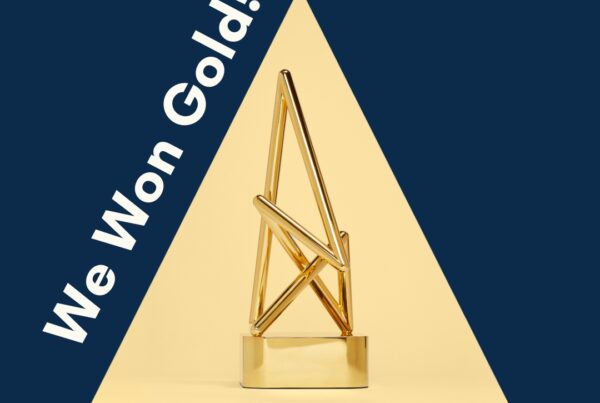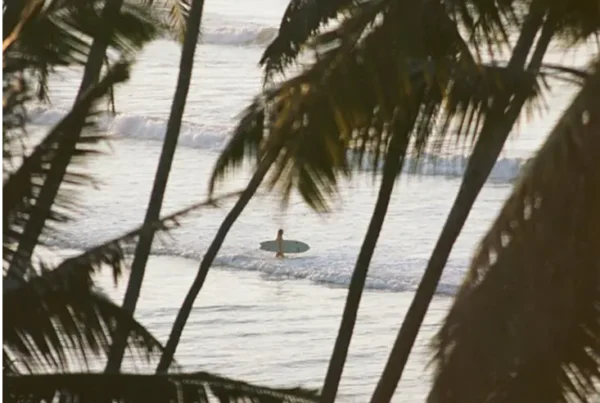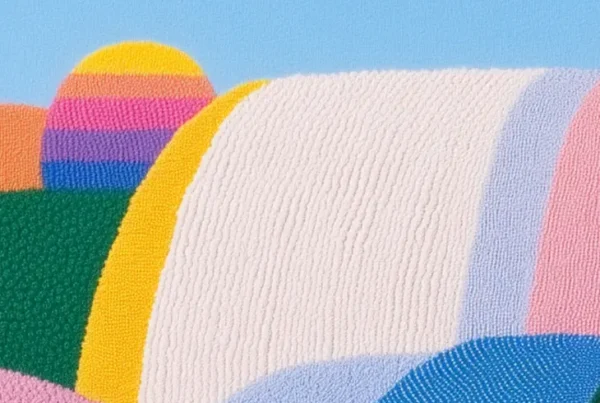Old Surfer, the change agency that takes companies to the crest of the sustainable
wave.
Oct. Forbes 2024.
On October 9th, Forbes Spain published the full interview with our CEO, Xavier Rubio Franch, where, in addition to sharing his personal story, he told us how Old Surfer has managed to connect sustainability with global brands, creating real change through innovation and creativity. The agency is now recognized as one of the top 5 change agencies.
Interview:
He got married on a surfboard and named his daughter Ona (sea wave). Although she doesn’t fully understand what her father does, she knows one thing: that he fights to protect dolphins and oceans. Xavier Rubio Franch is an old surfer for whom the ideas he stands by have no boundaries between the personal and professional worlds. This is why, in 2018, he founded Old Surfer, a change agency that connects sustainability with consumers and the purposes of brands. His daughter is not the only one who doesn’t fully understand what Xavier Rubio does; it’s what happens when you’re a pioneer and you blaze new trails. But one thing is clear to the companies working with him: their sustainability efforts yield tangible results, measurable positive impact, and also drive economic growth. We spoke to him to understand how the world is changed by generating geographical and ideological connections.
Since 2018, Xavier has been riding the crest of the sustainability wave, connecting it to consumers. But over the past six years, we’ve seen an accelerated and profound shift in mindset—how has this change been experienced from an agency like Old Surfer?
“It was a matter of time before companies and institutions understood that their sustainability efforts needed to connect differently with consumers, beyond expecting them to absorb the higher price of sustainable products. We needed a paradigm shift in the company-sustainability-consumer equation.
That’s why we define ourselves as a ‘change agency,’ with the mission of connecting sustainability with consumers, companies, institutions, and governments in a credible and attractive way.
Credibility is a duty, and remains one of the biggest challenges; but so is doing it in an attractive and clear way. Here we leverage our experience in advertising. The word ‘sustainability’ isn’t even easy to pronounce and can be approached in many different ways—from environmental issues to gender equality, health, and well-being—all while driving economic growth.
Additionally, we view this through our coast-to-coast vision, which allows us to reach both Europe and Latin America from Miami (USA), with transformative, varied, and impactful projects. When we consider the variety of sustainability discourses, and add the complexity of different regions with varying legislation and market maturity, it becomes clear that one of our original missions is to help companies streamline their sustainability efforts by connecting them to clear, credible, and understandable messages for consumers.”
Twenty years ago, people would’ve asked: who are the clients of a change agency—planet Earth and its inhabitants? How do you get consumer companies to connect with Old Surfer’s causes?
“Even in 2018, when we created Old Surfer, we had to convince companies that we weren’t some anti-system agency or an NGO. This came after the signing of the Paris Agreement—a historic 2016 pact involving 125 countries. Twenty years ago, even though the problem was known, we didn’t know when or how to start reversing global warming or gender inequality.
As passionate surfers and ocean lovers, we couldn’t let that wave of the Paris Agreement pass—a wave that brought together governments, major companies, and institutions seeking a paradigm shift. We created Old Surfer with the aim of helping key players reconnect with people and the planet without giving up their profits—driving transformation not only in brands and products, but also across industries.
Being pioneers in sustainability communication and creating global consumer studies, then sharing those insights, allowed us to develop our own methods and create simple, emotionally credible, and appealing solutions for consumers. That’s how we came up with our purpose: Sustainability Unlocked—to activate the sustainable side of companies (which doesn’t mean using the word ‘sustainability’ for everything).”
And speaking of 20 years ahead, at Old Surfer we’re already analyzing what consumers of the next 20 years will be like: Generation Alpha, the first truly native sustainable consumer generation, who will likely change the rules of the game.
“Being a bridge between the U.S. and Europe has shaped how we connect data, behavioral science, and creative emotions with clear messages—and that’s what has allowed us to become one of the top 5 companies connecting sustainability with consumers.”
Blazing trails often means surfing against the current. How did Old Surfer become both a change agency and an agent of change—and how does it differ from others with a similar mission?
“We were always clear on our purpose, and we knew it wouldn’t be easy since it was something relatively new. At times, we felt it was very difficult to paddle against the current because most companies were using traditional marketing strategies to talk about sustainability—which don’t actually work but have become the standard.
That’s when we applied a rule from surfing: don’t fight the current—use it to your advantage to reach the wave’s peak, and when you get there, exit the current to ride the wave, knowing that each one is different, unique, and unrepeatable.
So we embraced that metaphor and started by treating every project as unique. For example, institutions often have a solid sustainability approach—we help define their purpose, select the SDGs they want to focus on, and build a working plan around them. The challenge usually comes with brands, which prioritize sales and now must integrate sustainability into their DNA while being credible to consumers.
What makes us different—besides pioneering our own methods—is that we continue to innovate. Sustainability projects need many tailor-made elements to be credible, and that uniqueness helps them move away from generic marketing and buzzwords.”
Old Surfer is ranked among the top 5 companies with the most experience in connecting sustainability and consumers. How did you get there?
“As I mentioned earlier, traditional marketing strategies rarely work when it comes to sustainability. We carry out in-depth analyses—for example, we conducted the first and largest global study on the relationship between consumers and the Sustainable Development Goals (SDGs), with over 5,000 interviews across Europe, the United States, and Latin America.
We share this knowledge because we firmly believe the sustainability wave can’t be surfed alone. We opened all that data to leading companies, governments, and organizations. We encourage the generation of transformative ideas through a lab we created following that and other studies, applying the Nudge model (behavioral economics).
We measure and help track real change through tools like Green Story-Doing, which allows companies to credibly communicate their progress on the sustainability journey and avoid greenwashing in Europe.
Thanks to all of this, we’ve been recognized with awards in the U.S. like the Green Awards (also known as the Oscars of sustainability), which we’ve received multiple times. We’re currently nominated for the Anthem Awards, and we’ve just been named one of the 25 Changemakers by Success magazine.”
What is the “Nudge” model, and what insights does it offer about sustainable behavior? How do you apply this to campaigns that lead to real action?
“The term ‘nudging’ was coined by Richard H. Thaler, who won the Nobel Prize in Economics in 2017 for his contributions to behavioral economics. To make it simple, a nudge is a positive persuasion—a small change in the environment that can have a big impact on people’s behavior.
The theory suggests that by applying these ‘nudges,’ it’s possible to influence people’s decisions and actions without resorting to laws, mandates, or penalties.
After studying it in depth at the University of Chicago in 2021, we found a way to connect nudging to sustainability—driving behavior change based on two core ideas: the beautiful imperfection of human behavior, and the fact that we are all decision architects.
This led us to develop our own method, called EASTI, based on the English terms: Easy, Attractive, Social, Timely, Insightful.
At Old Surfer, we use this to find new ways for brands—through activations—to promote sustainable behaviors. The traditional route has always been about raising awareness, but that’s a long and often ineffective path. There’s a shorter route: understanding the context in which behavior occurs, anticipating negative behavior, and finally creating a positive one.
This expertise led us to co-found and chair the Foundation for Sustainable Consumption in the United States, where we apply the Nudge theory to areas like food waste (1.4 billion tons of food end up in the trash each year in the U.S.), or the vast amounts of plastic dumped into the oceans (only 9% is recycled, 12% incinerated, and 79% ends up in landfills or the sea).
This has enabled us to create joint projects like recovering disused fishing nets before they’re discarded and transforming them into basketball nets, which we distribute in underprivileged neighborhoods in collaboration with an NBA Finals player.”
“WE’RE ANALYZING WHAT THE CONSUMERS OF THE NEXT 20 YEARS WILL BE LIKE—GENERATION ALPHA, THE FIRST GENERATION OF SUSTAINABILITY-NATIVE CONSUMERS WHO WILL CHANGE THE RULES OF THE GAME.”
We’ve talked about the shift in mindset, but that also has a downside: more and more brands want to ride the sustainability wave—yet not all pursue real impact. Some fall into greenwashing. How do you avoid that?
“Greenwashing is a reality. In fact, Europe has led the way by creating an anti-greenwashing law. Thanks to that law, brands and advertising agencies have come to understand that sustainable marketing must be approached differently if it’s to be credible to consumers.
But I also want to talk about another concept that must be avoided: greenhushing—which is when brands stay silent out of fear that talking about their sustainability efforts could damage their reputation, even when they’re investing millions in transforming packaging, production, transportation, etc.
At Old Surfer, we’ve developed various anti-greenwashing solutions—one of the most well-known being the Green Story-Doing method. It serves as a middle-ground solution that helps companies communicate their sustainability progress credibly, recognizing that this is a long-term race.
Green Story-Doing is based on American storytelling principles, where the goal is to inspire—and ultimately evolve into storydoing. It’s no longer just about telling stories; the real challenge is to live the story.”
Company financial results, brand reputation, and relationships with stakeholders are creating a new narrative in sustainability—one where integral impact has a broader meaning. Historically, accounting systems were conventional, focused mainly on investors. Profits, stock prices, and cash flow were the core metrics. But now, new frameworks are emerging to measure a company’s full impact—on customers, suppliers, employees, communities, and the planet—not just investors. As board members in both the U.S. and Spain, how do you see this evolution?
“Sustainability has become a must—it’s definitely here to stay. We can say this confidently because we sit on the boards of several companies in both the U.S. and Spain.
What I do see are differences in the speed at which ESG (Environmental, Social, and Governance) policies are being adopted, and how committed different organizations are to their 2030 Agendas.
Here’s a new piece of optimistic data: together with the Bosch i Gimpera Foundation at the University of Barcelona, Old Surfer conducted a research project. Among many findings, it revealed that sustainability is a decisive factor for over 60% of consumers, and that actions related to climate action and life on land have the strongest influence on consumer perception—improving a brand’s market positioning by up to 41% as a sustainable brand.
These findings should encourage company boards to continue down this path. That level of credible positioning is undoubtedly a major asset for any business.”
“If the oceans were a country, they’d be the world’s seventh-largest economy. That’s why, in the realm of the blue economy, Old Surfer has a unique opportunity to create value through The Ocean Connections.”
Could you share some real examples that help illustrate Old Surfer’s positive impact chain and its causes?
“Initially, we focused on two sectors that urgently needed to improve their sustainability policies: FMCG (Fast-Moving Consumer Goods) and the oceans. But having the ability to develop highly specific projects has allowed us to work across many fascinating industries.
For instance, thanks to a nutrient-enriched egg, we created the first sustainable football team in Latin America, tackling the issue of chronic child malnutrition in Guatemala. Validated by the UN, this initiative made the egg the leading sustainable animal protein in 2022.
Speaking of the UN—during the height of the pandemic, we responded to a global call by launching Smile With Your Eyes, a movement to promote and provide face masks to combat early signs of depression. We developed the project and the campaign, which united 14 major European cities leading the conversation and action on sustainable growth.
Currently, among other projects, we’re working on a Living Spaces initiative to transform affordable rental housing in the U.S. into sustainable homes.
And finally, I’d like to highlight a project we started in 2019 and have been developing over the last five years: The Ocean Connections. It’s the first digital platform for changemakers—storydoers—in action for the oceans. This year, we’ve set ourselves the goal of rethinking the entire surf industry through sustainability. That means a deep cultural shift in an industry that hasn’t changed much in over 70 years.”
Founding Old Surfer and seeing its impact would be enough for most. But not for you: you’ve also created the Green Storydoing blog, the Foundation for Sustainable Consumption Inc., and the platform The Ocean Connections, which you just mentioned. Will this platform be your next big challenge in the advertising sector?
“Yes. We were born to unlock sustainability in brands, and staying true to our purpose, we believe the time has come to dive into our natural habitat: the oceans.
We must not forget the environmental and economic impact of oceans—on their coastlines, species, and communities. If the oceans were a country, they’d be the world’s seventh-largest economy. That’s why, in the realm of the blue economy, Old Surfer has a unique opportunity to offer differentiated value through The Ocean Connections.
On this platform, we create and connect projects with influencers, artists, Michelin-starred chefs, National Geographic oceanographers, sustainability directors, top One Young World entrepreneurs, foundations, elite football players, Olympic gold medalists, and global journalists—many of whom joined the cause 100% organically. Achieving that kind of reach would cost most companies a significant media investment.
For example, we created a project connecting a startup that collects ocean plastic and turns it into surfboards, with a foundation that helps children with autism spectrum disorder (ASD) improve their skills through their own therapeutic surf program.
Or we launched, together with Sergi Galanó, the project Flama Circular, which aims to rethink the surf industry—currently a major polluter due to the materials used in board production.
So yes, we believe now is the time to scale The Ocean Connections platform and leverage all the experience and networks we’ve built over the years to create a co-creation lab of experts focused on ocean protection. The goal is to generate specific, credible, high-impact projects and scale their reach across Europe and the United States. A unique lab that, once again, positions Old Surfer as a leader in innovative sustainability solutions.”
Beyond surfing in a metaphorical sense—you’re actually a surfer. How has that influenced Old Surfer?
“Yes, absolutely. Just as we speak about sustainability with credibility and coherence, it wouldn’t make much sense to create an agency called Old Surfer without being a surfer myself.
As someone from Generation X, I was often told not to mix pleasure and business—but I don’t agree with that. For me, it’s essential to connect the professional with the personal, and to always be purpose-driven and self-aware. Purpose helps me stay balanced, and I strive to maintain that balance across three areas: my professional life, personal decisions with my family, and surfing—which is my way of understanding life.
On top of that, I try to make sure that my lifestyle has a positive impact on everything around me. One detail that really illustrates that connection: I married my wife Julie on a surfboard in the Mexican Pipeline. Seven years ago, our daughter Ona was born (her name means “wave” in Catalan), and six years ago, on a family surf trip to Costa Rica—after reflecting on the global context I mentioned earlier—I decided to launch Old Surfer.
Today, when I show some of our campaign materials to my daughter Ona, she still doesn’t quite understand what I do—but she tells her friends that her dad helps protect dolphins, whales, seas, and oceans. I think that’s the most beautiful thing in the world. That kind of impact is the greatest recognition I could ever receive—because everything flows naturally, just like waves breaking on the shore.”
We are proud to ride waves as big as Forbes—waves that push us to take our ideas even further and inspire companies toward a more sustainable future.
Read the full interview on Forbes here



